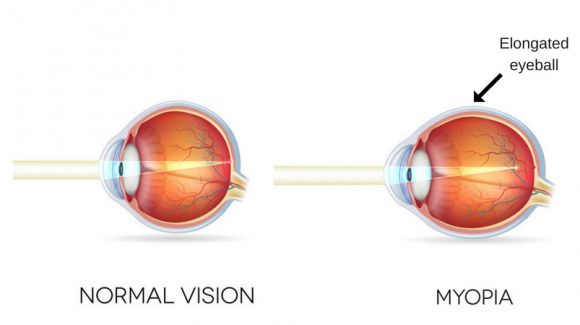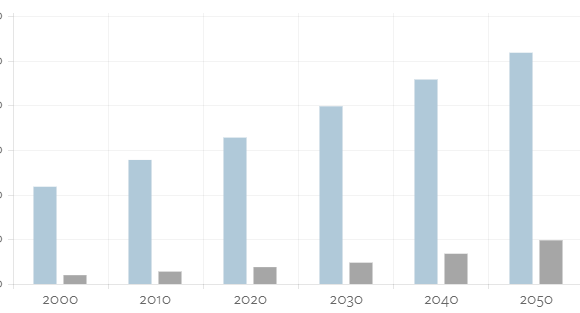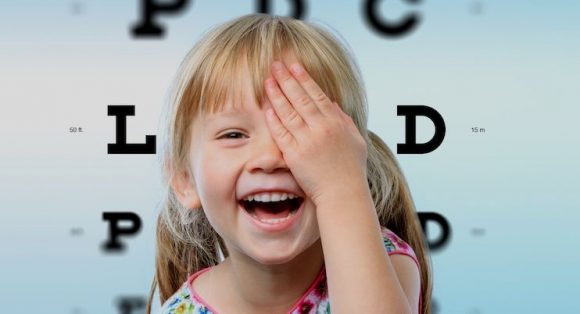Myopia, or nearsightedness, as it is more widely known, is a common vision condition where you are able to see objects closer to you clearly, but objects far away are blurry. Myopia occurs when the shape of the eye causes the light to refract (bend) incorrectly which focuses images in front of your retina instead of on your retina. People with myopia are at a higher risk of eye diseases such as glaucoma, cataracts, retinal tears which can lead to retinal detachment and macular degeneration. The risk of these conditions are greater for people with high myopia.

Research has shown that in the past 30 years, myopia among 12 – 54 year olds has increased 25% in the United States. In a recent Canadian study for the University of Waterloo School of Optometry, it found that myopia increased from 6% to 28.9% between the ages of 6 and 13. Leading researchers in both the United States and Canada have noted that myopia used to start at age 12 or 13, but is now showing up more often in kids as young as 6 or 7 years old.
Estimated prevalence of myopia globally from 2000 to 2050

The World Health Organization (WHO) has reported “myopia and high myopia are increasing globally at an alarming rate, with significant increases in the risks of vision impairment from pathologic conditions associated with high myopia, including retinal damage, cataract, and glaucoma.” Following a recent study, the WHO estimated myopia affects 29.8% of the general population and that by the year 2050, more than 50% of the general population will be near-sighted. A 2016 study by Holden et al, also reported by the year 2050, 10% of the population (or 1 billion people) will have high myopia and be at risk of vision impairment and blindness.
The increased relative risk associated with myopia are summarized below.

There are currently four types of widely accepted myopia control treatments. Orthokeratology (Ortho-K), atropine eye drops, distance-center multifocal contact lenses and bifocal or multifocal glasses. Our doctor will happily go over the options and you can figure out together which would be best for yourself or your child.
1. Orthokeratology (Ortho-K), is a method where medical devices that are similar to contact lenses are applied to the eye whilst asleep. The gentle pressure of the lens overnight results in a temporary molding of the eye’s outer layers which provides the user with a lens like effect where they are able to go about their day without the need for contact lenses or glasses. This treatment is great for people who enjoy activities where glasses and contacts might be a burden such as swimming and other sports.
2. Atropine eye drops are also an effective way of slowing the progression of myopia, with some studies showing that by using the drops, the progression can reduce by 77%. In some cases, atropine drops can be used as well as bifocal glasses to enhance myopia control.
3. Distance center multifocal contact lenses are worn just like regular contact lenses. These lenses have an optical “trick” in the center of the lens which has been shown in several studies to slow down the progression of myopia. One recent two year study found that nearsighted children who wore these types of lenses on a daily basis had a 50% reduction in the speed of progression of their myopia compared to children who just wore regular soft contacts for the same amount of time. This method is increasing in popularity.
4. Multifocal glasses work similarly to multifocal contacts to help users to slow down the progression of myopia. Most studies show that the use of multifocal glasses for myopia control has only a mild slowing effect. However, one three-year study of Chinese-Canadian children found that by wearing multifocal glasses slowed down myopia by 51%, compared to children who wore regular glasses.

Specific types of glasses and contact lenses have been shown to control the progression of myopia effectively. Ortho-K lenses, distance-center bifocal contact lenses and bifocal glasses are all methods where studies show that their use has an effective way of slowing down or preventing the progression of myopia.
If you have any questions about any of these treatments, feel free to call the office at 604-671-0690 or email us at [email protected] to learn more.


